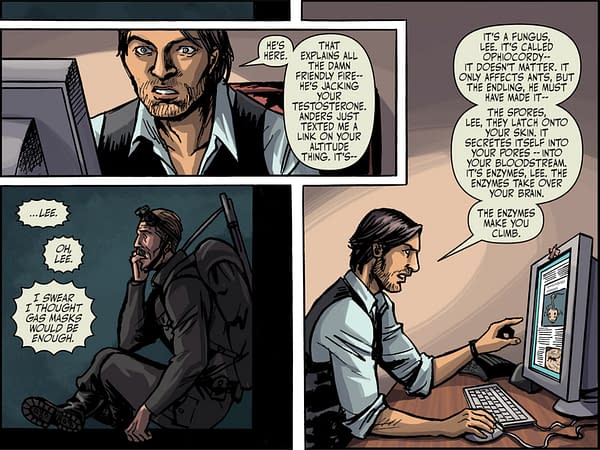Posted in: Comics, Recent Updates | Tagged: Cecilia Latella, Comics, digital comics, entertainment, Jenn Manley Lee, Jonathan Larsen, mark waid, The Endling, thrillbent, Troy Peteri
Thrillbent's The Endling Returns To Haunt Your Future – Talking With Jonathan Larsen Plus Preview
Jonathan Larsen is the writer on a comics project known as The Endling that appears on Thrillbent on Thursdays in chapter format. Over the course of 20 chapters, Larsen and The Endling team have established an unusual and thought-provoking storyline which moves from a research project simulation about the future evolution and reproduction of the human race, to the lives of the two characters, Amber and Zavi, who are engaged with running the simulation, but who find that ideas can become incredibly dangerous and have real-world implications beyond their wildest imagination.
The Endling has been on hiatus before returning this week to Thrillbent for its next 20 chapters, and Larsen joins us here on Bleeding Cool to talk about his experience working with the "swipe" functionality of Thrillbent and pursuing The Endling as it develops for him as a writer and as a fan-influenced comic. He has also kindly provided us with an advanced preview of the new chapter coming this week to Thrillbent. For those unfamiliar with Thrillbent, this digital comics platform allows free readership while the comics are also available for purchase through their store.
Hannah Means-Shannon: How does writing for a Thrillbent comic with the platform's functionality cause you to compose differently as a comic writer?
Jonathan Larsen: I'm actually pretty new to writing comics—I co-wrote an obscure book called Rant with my old buddy JG Jones, and then recently did two Batman stories for DC's Legends of the Dark Knight series—so the transition hasn't been as jarring as it might've been if I were more experienced. In fact, because I work in television—primarily news—the element of motion or at least visual transition in storytelling doesn't feel super-alien to me.
James Tynion IV has The Eighth Seal up on Thrillbent, too, and he's had some smart things to say about the implications of Thrillbent's swipe functionality specifically for the kind of jolt-you-back-in-your-seat horror he's doing. James and I hadn't met when I wrote The Endling, but it turns out we were having similar writing experiences. To give an example, when you're writing horror—or suspense, which is related—you can heighten it in prose by drawing out the lead-up to your payoff, zooming in on the agonizing details of what your characters are doing. That's a lot tougher to pull off in standard print comics, I think—you only have so much real estate to dedicate to chronicling …each…moment…of…the…victim…reaching…for…the…doorknob…of…the…door… they…were…specifically warned not to open.
Thrillbent's swipes make that kind of attenuation possible. Plus, I love that while print hands control to the reader only on the page turn, in Thrillbent's format, you can put the reader in charge any time you want…for any part of the screen you want. The reader controls the pace and makes each reveal happen. I have one sequence in which someone's finger does something unexpected and nasty—but once it starts, the reader knows something creepy is coming, which makes them complicit in the finger's subsequent motion. The reader's complicity adds a whole 'nother creepy layer to it, I think. So it's been fun to play with the possibilities opened up by that, and it's definitely driven the writing to exploit those possibilities as much as makes sense for the overall story.
In theory, Thrillbent allows for potentially infinitely long comics—you could link the last screen to the first, for instance, or have one screen repeat ad infinitum (at last, Waiting For Godot as it was always meant to be!). The downside I found is that even a seemingly minor change to a single panel results in disproportionately more work for the artistic team. That's a big part of why we took the hiatus—penciler/inker Cecilia Latella and colorist Jenn Manley Lee were perfectly diligent on their end, but I underestimated the workload implications of the swipes and so the prodigious number of swipes per issue simply meant we had more screens than they could execute in a given week.
Luckily, Cecilia and Jenn (and letterer Troy Peteri) kept up the pace while we paused publication, so we've got several issues in the can and expect to continue our weekly pace right through to the end.
HMS: In some ways, The Endling has a bleak vision of humanity's future. Is engaging with the future in the "present" of the series a way of encouraging us to attempt to alter our own future outcome in our own present?
JL: In upcoming episodes, we'll get a better sense of exactly why the computer simulation of our future is so bleak, but you're right that I saw the simulated future as a way to speak to the present day on big social issues (like climate change) but also on the culture and values that drive Amber and Zavi to do what they do. I hope once the story's done, the simulated future will seem less like a familiar dystopic warning and more like an attempt to broaden the way we think about which social values are inherent and immutable and which are not. By the end, I hope readers will be thinking in those terms not just about the two worlds in this story, but also about the contrast in how Amber and The Endling pursue their goals.
One theme I don't explore as much as I wanted to—but would love to if reader response to the series merits a followup—is the fact that humanity evolves not just physically but psychologically. Natural selection can weed out emotions and values—based on whether those emotions and values inhibit or enhance genetic replication (meaning, of course, procreative sex).
The values we extol or deride now will shape who is seen as good genetic breeding stock and who isn't, right? The economic and cultural dynamics we establish—wittingly or not—influence who has children, when, and how many.
So, yes, to (finally!) answer your question, I did create these two worlds at least in part as a way to explore how the social choices we make now will literally affect the genetic course of our species. Whether I get to do that more in a future story depends on the kind of response we get to the first story!
HMS: Why use two "worlds" structurally in a comic rather than flashbacks and flashforwards? How did you decide on this artistic choice for The Endling?
JL: In one respect, it was purely incidental. I wanted to focus on the last genetic human—"endling" is the biological term for the last individual of any given species—but I thought setting the story in the future, or using time travel to bring The Endling back to our time, would prove too jarring, make the present-day world feel too different from our own. The solution—a computer simulation of human evolution—meant that the present and future would elapse in parallel (albeit at different rates—you obviously can't simulate the future in real time.)
Also—allowing the reader to see what's developing in the moment in The Endling's simulation while Amber remains blissfully unaware (for now) in the real world, lets me raise the stakes from a storytelling perspective with an immediacy that flashbacks and flash-forwards might not generate.
The other confession I should make is that our gracious Thrillbent co-publisher and de facto editor-in-chief Mark Waid had some concerns about the level of action in the first few issues. While it ramps up decidedly down the road, I wanted to do the beginning old school, like a '70s disaster movie—introduce Amber and Zavi, let readers see and enjoy their relationship and let Amber tell us who she is and what she wants in life. The parallel structure allowed me to get some action into the mix and simultaneously start to hint at The Endling's capabilities.
An otherwise positive review of our first Comixology collection gently noted a perceived dearth of action early on…and in a (totally friendly) exchange, I responded:
"I do want to point out that the first collection of four issues includes one death by choking, one death by impaling, one mob brawl and one stabbing in the face with a fork".
So, although the series is set in the relatively peaceful present-day New York City area, our parallel structure with the simulated future allows for a continual, healthy supply of high-brow, high-octane, quality violence.
HMS: Do the science and biology-based aspects of science fiction in the series require a lot of research for you? What sort of preparation and reading goes into writing The Endling in a believable way for readers?
JL: I'll cop to it now and say it wasn't a huge amount of new research. I became familiar with zoologist Richard Dawkins' writing on evolution back in college. My faculty advisor, Dan Dennett, has also written about evolution and natural selection. So for most of my adult life I've been exposed to thoughtful contemplation of evolution and natural selection in terms of how they drive not just physical but also social and psychological change. The word "meme," in fact, was coined by Dawkins to get us thinking about the transmission and replication of ideas in evolutionary terms the same way we think about genes and the way genes replicate.
In terms of research I did specifically for The Endling, most of that was driven by my desire to ensure that his abilities did not mirror the standard "animal powers" template. He can fly like an eagle! Run like a cheetah!
Those kinds of powers never made sense to me, because they're structural. It would be like writing about a fish that acquired the power to walk. Without legs, that's called "magic." So I knew I wanted to identify unusual "animal powers" that we haven't historically seen in comics, but also abilities that had a genetic basis in reality and so could conceivably come to evolve in the human genome. That led me to scour the obvious sites—although I must confess I started at io9 a lot more often than I did at scholarly sites—for unusual abilities that occur not just in the animal kingdom, but among bacteria, etc.
Some of The Endling's abilities also came from stuff I picked up in college, where I majored in philosophy. Without giving too much away about The Endling, some naturally occurring phenomena have literally brain-bending implications for the ways we think about intentionality and consciousness—which fortunately for my story also lend themselves to some really creepy, memorable ways of killing people.
As far as believability, I tend to aim for verisimilitude, the quality of feeling believable to the reader, rather than the actual ability to survive a fact-based challenge. Either way, the story gives just enough information that anyone can go check out the biological bases for The Endling's abilities—and judge for themselves how much violence I've done to their plausibility.
HMS: So, we're at the mid-point of the series, at 20 chapters, with 20 to come. What is it about the comic at this point that most fires your imagination? How has the comic changed for you over time from your initial ideas to the current new issue?
JL: I actually finished writing it about a year ago, so the thing I'm most fired up about now is seeing how people react to the various surprises that lie ahead. Mark [Waid] told me he had had doubts the story would work and retain reader interest for forty issues, but after reading the all the scripts, Mark wrote me pretty much the nicest email I've gotten in my life:
"…fuck you. Finished Endling again from start to finish and it's just about the most damn compelling thing I've read in forever. Plot twists are paced out sweetly and perfectly, dialogue is bang-on, the speech [REDACTED] gets about [REDACTED] was really stunning…"
As you can imagine, that kind of reaction from MARK! WAID! has kept me on cloud nine, so I'm terribly excited to see whether readers share even a fraction of Mark's enthusiasm once they read the whole thing.
In terms of what I'm most excited about in the story at our current midpoint…the action and intensity and stakes have steadily ramped up over the first 20 issues. Volume 2 kicks off right in the middle (so start with Volume 1!) just as we hit the payoff for it all—an extended battle/chase that really blows the doors off in terms of revealing just exactly what The Endling is capable of. I loved loved loved writing some of the sequences here and I think they'll cling to the inside of readers' brains for a long time afterward.
As far as how the comic changed for me—Amber and Zavi and The Endling and all the others simply took over. I'm not one of those writers who says their characters write themselves. I tend to work the other way—letting the plot I have in mind push me to figure out character motivations, hopes, fears and secrets that would make sense of their actions. That forces me to reverse-engineer character elements I never would've thought of otherwise. In the course of doing that, the characters have taken center stage for me. I don't think Amber and Zavi are clear-cut heroes—because that's unrealistic and, at least to me, uninteresting. Everyday people become heroes every day by putting themselves in harm's way for the sake of others, but when you're not talking about imminent emergencies…as situations become more nuanced…very few people who have to make big decisions about complex problems emerge without having people disagree with their decisions, question their motives, etc.
We have a Facebook page and folks chime in on Twitter, so it's been a true pleasure seeing people react to, disagree with and challenge Amber, Zavi and The Endling; reading into their motives and characters elements I never saw or intended.
Maybe that's what makes it realistic!
HMS: Thank you, Jonathan for such open and thought-provoking answers to our questions here on Bleeding Cool. Now let's prep the readers for the preview of Chapter 21 coming this week to Thrillbent by catching them up…
Jonathan has given the following explanation of the series so far for us:
"In Volume 1 of The Endling–which you should read first!–a simulation of the last human shows up in the computer of a bio lab where high-school student Amber Black has an internship. The Endling wins Amber's help to escape the dangers of his world…but those dangers follow Amber into the real world, drawing a mysterious paramilitary force to the lab to stop them.
Volume 1 ends with the paramilitary group shooting their way into the lab and cornering Amber along with her friend Zavi–just as Amber begins to question The Endling's true motives. Volume 2, Issue 1–by Jonathan Larsen, Cecilia Latella, Jenn Manley Lee and Troy Peteri–picks up at Thrillbent.com on Thursday, and as you'll see in this exclusive sneak preview, something unexpected–and unsettling–is about to happen to Amber's attackers…"
Here's our preview of what's coming for The Endling this Thursday:
























